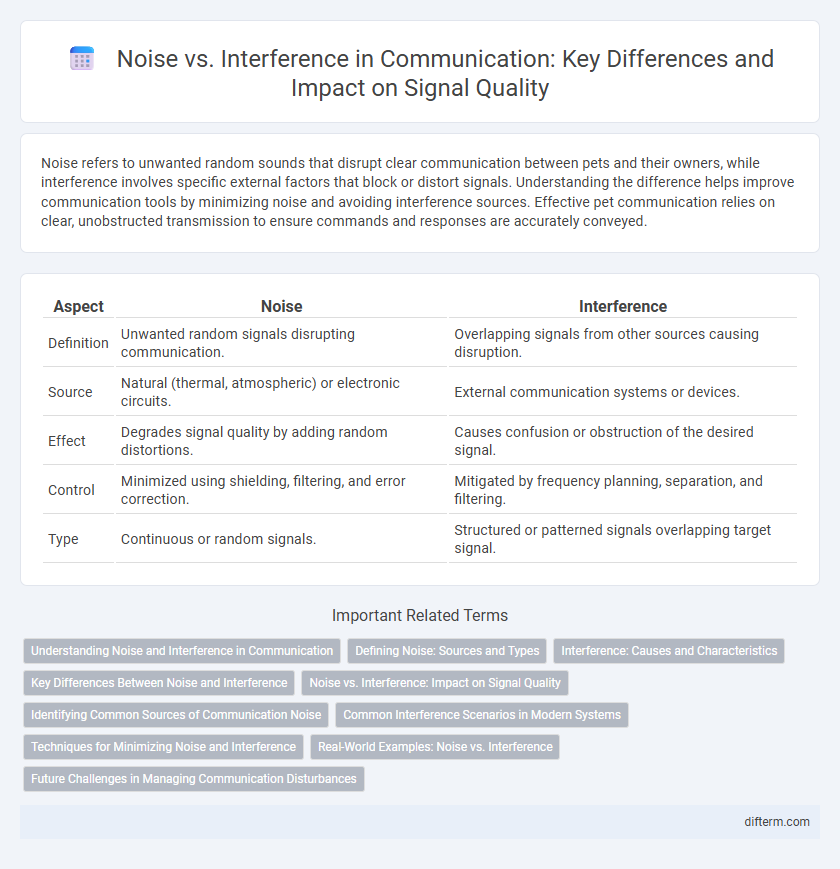Noise refers to unwanted random sounds that disrupt clear communication between pets and their owners, while interference involves specific external factors that block or distort signals. Understanding the difference helps improve communication tools by minimizing noise and avoiding interference sources. Effective pet communication relies on clear, unobstructed transmission to ensure commands and responses are accurately conveyed.
Table of Comparison
| Aspect | Noise | Interference |
|---|---|---|
| Definition | Unwanted random signals disrupting communication. | Overlapping signals from other sources causing disruption. |
| Source | Natural (thermal, atmospheric) or electronic circuits. | External communication systems or devices. |
| Effect | Degrades signal quality by adding random distortions. | Causes confusion or obstruction of the desired signal. |
| Control | Minimized using shielding, filtering, and error correction. | Mitigated by frequency planning, separation, and filtering. |
| Type | Continuous or random signals. | Structured or patterned signals overlapping target signal. |
Understanding Noise and Interference in Communication
Noise in communication refers to any unwanted random disturbances that degrade signal clarity, such as thermal noise or electromagnetic interference. Interference specifically denotes external signals overlapping the original transmission, causing distortion or loss of information. Distinguishing between noise and interference is crucial for designing effective communication systems that maintain signal integrity and optimize data transmission quality.
Defining Noise: Sources and Types
Noise in communication refers to any unwanted or disruptive signals that degrade the clarity of the message being transmitted. Common sources of noise include thermal noise generated by electronic components, electromagnetic interference from nearby devices, and environmental factors like static or background sounds. Understanding these noise types--such as white noise, impulse noise, and crosstalk--is essential for designing systems that minimize data loss and enhance signal integrity.
Interference: Causes and Characteristics
Interference in communication arises from external sources such as electromagnetic signals, overlapping frequencies, and physical obstructions that disrupt signal clarity. It is characterized by signal distortion, data loss, and reduced transmission quality, often caused by devices like microwaves, wireless routers, and faulty cables. Understanding interference patterns enables the implementation of mitigation techniques like shielding, filtering, and adaptive frequency hopping to maintain optimal communication performance.
Key Differences Between Noise and Interference
Noise refers to unwanted random signals that degrade communication quality, typically arising from natural sources like thermal vibrations or man-made electronic disturbances. Interference involves unwanted signals from other communication channels or devices that disrupt the intended transmission by overlapping frequencies or causing signal distortion. While noise generally reduces signal clarity by adding background disturbances, interference actively disrupts communication by competing with or overwhelming the original signal.
Noise vs. Interference: Impact on Signal Quality
Noise refers to random, unwanted electrical signals that degrade overall signal quality by increasing the error rate and reducing clarity. Interference involves external signals from other sources that disrupt communication channels, causing distortion and data loss. Both noise and interference significantly impact signal integrity but differ in origin and mitigation techniques.
Identifying Common Sources of Communication Noise
Common sources of communication noise include physical distractions such as loud environments, technical malfunctions like static or poor signal quality, and psychological factors including stress or preconceived notions. Environmental noise disrupts message clarity by distorting sound waves, while semantic noise arises from ambiguous language or jargon. Identifying these barriers allows for targeted strategies to enhance message transmission and reception in various communication settings.
Common Interference Scenarios in Modern Systems
Common interference scenarios in modern communication systems include electromagnetic interference from nearby electronic devices, multipath fading caused by signal reflections, and co-channel interference from overlapping frequency bands. These types of interference degrade signal quality, leading to data loss and reduced communication reliability. Effective mitigation techniques involve using shielding, adaptive filtering, and dynamic frequency selection to minimize the impact on system performance.
Techniques for Minimizing Noise and Interference
Effective techniques for minimizing noise and interference in communication systems include the implementation of shielding, filtering, and proper grounding to reduce electromagnetic disturbances. Advanced modulation methods like spread spectrum and error correction coding enhance signal integrity by mitigating the impact of noise. Adaptive equalization and frequency hopping further optimize communication channels by dynamically adjusting to interference patterns.
Real-World Examples: Noise vs. Interference
Noise in communication systems includes random background sounds such as static on a radio or electrical hum in audio equipment, which degrade signal clarity. Interference arises from overlapping signals, like Wi-Fi routers competing on similar frequencies or cell towers causing dropped calls in crowded urban areas. Understanding real-world examples of noise versus interference is crucial for designing robust networks and improving data transmission quality.
Future Challenges in Managing Communication Disturbances
Future challenges in managing communication disturbances involve differentiating between noise and interference, as both degrade signal quality but require distinct mitigation strategies. Advanced technologies must adapt to increasingly complex environments where electromagnetic interference and ambient noise escalate due to expanding wireless device usage and heterogeneous network infrastructures. Developing intelligent filtering algorithms and dynamic spectrum management will be crucial to maintaining signal integrity and ensuring seamless communication in next-generation systems.
noise vs interference Infographic

 difterm.com
difterm.com